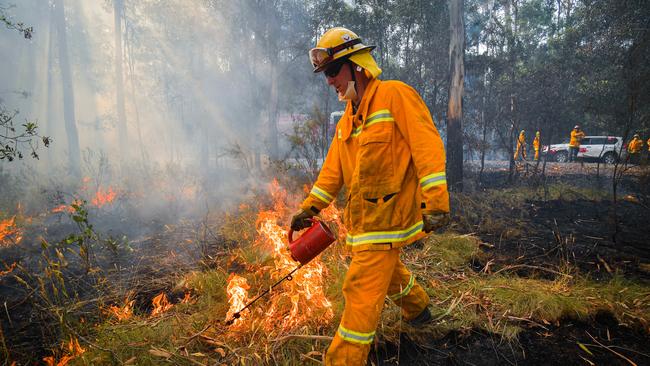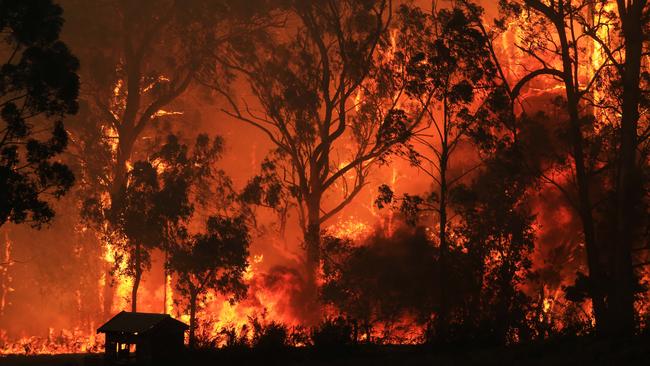Bushfires crisis: Burning questions over hazard reduction
All agree that hazards need reducing but there’s heated division about how this is best achieved. How much to burn? And where?

While Australia continues to battle its fiery nemesis, Mother Nature, no debate has generated as much heat in this present crisis than the furore surrounding hazard-reduction burning.
Prescribed burning as a means of reducing bushfire risk has been standard practice in Australia for thousands of years. The knowledge of indigenous Australians in relation to fire mitigation is highly valued by state agencies charged with managing bushfire risk.
LIVE: Follow the latest on the bushfire emergency
But the questions about its effectiveness — How much to burn? Where to burn? Does it do more harm than good? Are alternative prevention methods better? — continue to proliferate.
Some argue that more planned burning needs to be done to reduce the risk while others say it should be less because of the ecological damage and the health effects of particle-laden smoke. Still others say it is not about how much controlled burning there is but about where it occurs.
One thing is certain: the amount of hazard-reduction burning that has happened in recent years is much less than what was planned for, meaning increases in fuel load. We are seeing the consequences of that now.

Black Saturday’s legacy
Those who favour the benefits of hazard-reduction burning point to the findings of the royal commission into Victoria’s 2009 Black Saturday bushfires, the worst in the nation’s history. The royal commission urged the setting of an annual rolling target of burning 5 per cent of public land, up from the target of less than 2 per cent before the series of fires north of Melbourne that killed 173 people.
That recommendation set into the national consciousness the notion that the remedy to ensuring safety from out-of-control bushfires was prescribed burns that reduce fuel load.
It also put pressure on state governments to meet numerical targets for prescribed burns. But that, according to some experts, is the wrong approach entirely.
The latest State of the Environment report for Victoria has much to say about the value of more controlled burns given their ecological impact.
“The increase in planned-burning area since 2009-10 was a response to recommendations by the royal commission that opportunities for planned burns should be maximised where possible to reduce fuel loads in Victorian forests,” it said.
“However, such recommendations do not adequately address aspects of forest ecosystem health, such as the risk of extinction in a range of native species. Biodiversity in the Mallee shrub lands and in the woodlands of northwestern Victoria is particularly at risk.”
The report also points to the increased risk to people from the small PM2.5 particles carried in the smoke generated by controlled burns.
Such criticism spurred the Victorian government to shift the focus of its hazard-reduction burning program more to risk management than raw numbers about three years after the royal commission’s recommendation.
But the public perception about the value of controlled burns lingers, and this is creating all manner of political dilemmas.
The government has stated it wants the residual bushfire risk for Victorians to remain below 70 per cent. This number fluctuates according to the success of controlled burning and in the aftermath of major bushfires. But without any prescribed burning, the Department of Environment, Land, Water and Planning estimates this risk would increase to just under 80 per cent.
Victorian Premier Daniel Andrews defended a reduction in controlled burns conducted in Victoria, saying the number of days each year when they can safely take place has fallen.
“The number of days in each year that we can safely put fire in the landscape and still call it a controlled burn — that is to say, avoid what happened in Lancefield a couple of years ago where it started off as a controlled burn and next thing we had to apologise to people (for) having burnt their houses down — the number of days we can safely backburn is getting less and less each year,” Andrews said.
‘Perverse outcomes’
La Trobe University fire ecologist Mike Clarke says the focus on a volume-based target such as that urged by the royal commission has led to some “perverse outcomes”.
“The calls for just blanket burning everywhere haven’t been helpful,” he says.
Better, he says, that more thinking goes into using planned burning as one tool of many because preparing for bushfires needs to become more strategic and sophisticated if it is to have any chance of protecting Australians.
“We need to make sure controlled burns happen close to the assets we want to protect, not miles away from them,” he says.
Clarke wants three things to happen: a rigorous analysis of how and why bushfire hazard conditions have changed in Australia and what science exists to better predict risks; a critical evaluation of what options are available to better handle these conditions; and an end to the blame game and an admission that all levels of government and all Australians share the roles and responsibilities needed to address the causes of climate change.
“We are clearly entering uncharted waters, more of the same is not an option,” he says.
So far, however, more of the same is dominating the policy stage. The problem is that meeting public expectations becomes more and more difficult as the scale of the threat posed by bushfires since Black Saturday has only grown.
Burn plans unmet
The latest figures on prescribed burning from Queensland Fire and Emergency Services are a case in point. Of the 812 hazard-reduction burns QFES planned for since 2016, just 439 have been completed. This despite the demonstrated need for the state to reduce its fuel load, given the increased bushfire risk in recent years.
Long used to dealing with the devastation of regular flooding and cyclones, Queensland has now had to count bushfire as a likely cause of natural disaster.
In November 2018, the state endured catastrophic fire conditions for the first time in its history. This season, Queenslanders have witnessed bushfires burn 250,000ha and destroy 48 homes, with some of the worst damage occurring in areas covered by lush jungle-like wet sclerophyll forest.
Such unprecedented scenes have fuelled calls for more prescribed burning and growing criticism of the state government regulations, seen by some landholders to have made proper planning for bushfires impossible.
Fire and Emergency Services Minister Craig Crawford says the usual annual mitigation activities under what is dubbed Operation Cool Burn have been constrained in recent years.
“I am advised by QFES that the number of hazard-reduction burns and other mitigation activities fluctuates from year to year because of variable weather conditions,” Crawford said on Tuesday in an answer to a parliamentary question-on-notice.
“For example, dry conditions experienced in 2018 and 2019 have severely reduced opportunities for hazard-reduction burning and in 2018 Operation Cool Burn ended early due to the very active early bushfire season.
“In other years, the weather conditions can be too wet to conduct planned burns.”
These factors do not seem to have bothered other state agencies as much. The Queensland Parks and Wildlife Service, which is responsible for bushfire management in national parks and state forest, recently reported that it had undertaken planned burns of more than one million hectares of estate under its control, nearly double its annual target.
Crawford stressed that the role of QFES was to provide advice to landholders. It is up to whoever manages the land to conduct the burning.
“The primary responsibility for hazard-reduction burns is with the landholder, who may decide weather conditions are unfavourable or dangerous, or that they need to preserve fodder for livestock,” he said.
In any case, there are plenty lining up to suggest that simply increasing prescribed burning in order to reduce bushfire risk is no “magic bullet”.
Clarke says: “I suspect the public think they get a lot more bang for their buck from controlled burning than they actually do.”
He says bushfire mitigation should focus more on ensuring at-risk communities have safe places to shelter with protected bunkers, honing the message about preparing for fires and encouraging better town planning regulations and building codes.
“In the past we could be assured that damp parts of a forest would stop the burn, but now fires are burning right through rainforest gullies,” he says. “If that is the new normal then we need to think about how to best prepare for those sorts of scenarios.”
Prescribed burning should always be used as a mitigation tool but it cannot just be government agencies carrying the load, he argues. “Private landholders also have a responsibility along with government agencies if we are to be really safe.”
As far back as 2002, a NSW parliamentary committee into the Black Christmas fires — which devastated swaths of national park around Sydney that year and destroyed more than 100 homes — urged reform of the responsibilities and protections of private landholders in relation to controlled burns.
The committee’s report found there “is no simple answer to the issue of fuel reduction burning because of the diversity of forests, topography and climates in southern Australia as well as the different priorities that different land managers have in developing specific burning regimes”.
That same year, a commonwealth Parliamentary Library research paper into the fires insisted “it is absolutely essential that all land managers (public and private) are obliged to design and implement their fuel reduction programs to protect life and property within and beyond their land boundaries”.
However, as Queensland Inspector-General of Emergency Management Iain Mackenzie found in his review of the 2018 fires in that state, one thing that can snuff out all the good intentions around hazard-reduction burning is red tape.
A major complaint to that inquiry centred on the difficulty landholders struck in getting the necessary permits to conduct controlled burning on their properties.
In his report, Mackenzie found “some landholders see legislation and ‘permit to light’ regulations that guide mitigation activities as complex, and a barrier to effective bushfire mitigation”. “Submissions were received from rural and suburban residents who railed against the ‘timidity’, which resulted in legislation to enable the effectiveness of preparedness activity (through requisitions for hazard-reduction measures) remaining unused, and who recognised the need for more practical laws for mitigation burning.”
Among his 23 recommendations, he urged the Queensland government to do better in looking after private landholders who wanted to conduct hazard-reduction burns.
“Given an increasing risk of intense fires, the framework of legislation relating to vegetation management, bushfire mitigation and hazard reduction, together with mitigation and preparation priorities should be reassessed,” his final report said.
“The reassessment should aim to enable more appropriate and flexible means at the local level for the reduction of intense fires.”

To join the conversation, please log in. Don't have an account? Register
Join the conversation, you are commenting as Logout